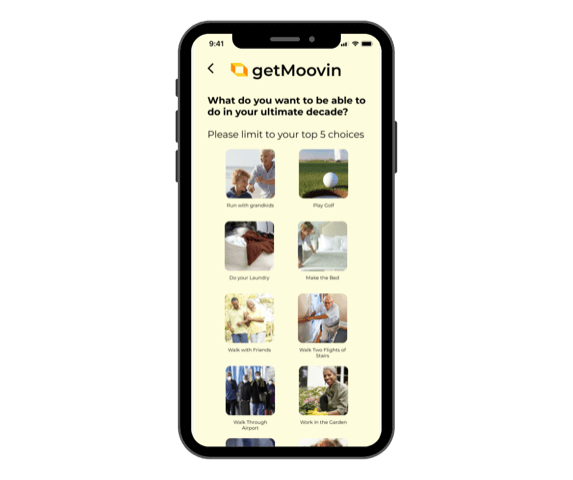Health Technology Showcase
Five Questions and an Elevator Pitch: GetMoovin
 Team GetMoovin created an app that encourages people to exercise, in part, by sharing photos with their community.
Team GetMoovin created an app that encourages people to exercise, in part, by sharing photos with their community.
1. What is the need that your project seeks to address?
Jack: Lifespan is how long you live and healthspan is how long you live well. We want to increase people's healthspan and address how aging affects seniors.
Starting in our late 30s, we all lose 1-3 percent of lean muscle mass every year; the same for bone density and cardiovascular fitness. As aging progresses, people become less functional, frequently experience social isolation, and often cannot take care of themselves. Of the seniors we interviewed, almost all of them feared that they would become burdens on their family.
Problems generated by inactivity cost the healthcare system over $117 billion a year. And that excludes out-of-hospital and out-of-doctor’s-office costs.
What is the answer? Exercise, by far, is the most important thing you can do to mitigate these aging-related changes. You can't stop them, but you can really slow them down and improve your healthspan.
2. How does your solution work?
Jack: In the United States, only one in four adults over the age of 55 meets the Department of Health and Human Services’ exercise recommendation for a healthy lifestyle, which is 30 minutes, five times a week. With GetMoovin, we’ve taken a personalized approach, combined with a focus on building community engagement and being very low cost, to make exercise relevant.
Our core technology has two components. The first is a free photo-sharing feature that enables people to share photos of themselves exercising with a group of friends and family members. The second is a subscription service that provides a personalized plan based on the answers to two questions: 1) How old do you think you will be in your ultimate decade? and 2) What do you want to do in that decade?
We’ve gotten responses like, ‘I'd like to be able to pick up my grandchild,’ ‘I'd like to get on the floor and play with him,’ or ‘I want to put the carry-on into the overhead bin on the airplane and not have it fall on my head;’ and ‘I just want to be able to clean my house and take care of myself.’
GetMoovin converts each type of activity people want to be able to do in their ultimate decade into exercises. We calculate what they need to be able to do today in order to play with a grandchild or clean the house when they are older. Our app helps our users design the activities they need to be doing today, so they can do what they want in the future.
 GetMoovin asks seniors what activities they would like to be able to perform in their final decade and then suggests exercises to help ensure they reach their goals.
GetMoovin asks seniors what activities they would like to be able to perform in their final decade and then suggests exercises to help ensure they reach their goals.
3. What motivated you to take on the project? And what activities have you undertaken?
Jack: We asked students in the Biodesign for Digital Health class if they were worried that either a parent or grandparent wasn't exercising enough. Every single hand went up. We see this in our own families. We want to help people improve their healthspans so they can enjoy their lives.
When we asked people why they weren’t exercising, a lot of them replied, ‘It's boring,’ or ‘It's painful,’ or ‘I don't want to do this.’ Others said, ‘It's too much trouble to go to the gym,’ or ‘I don't have the time.’ Based on the science of aging, it's critical that people exercise. Our job is to make exercise relevant, convenient, and fun.
Natasha: On the technical side, we have an initial MVP [minimal viable product] that we were able to program in CS 342: Building for Digital Health. We have presented the idea to a number of seniors, but we need to test it with many more users and get feedback to iterate and improve the model. We also want to onboard a coder who is passionate about the concept and has the skillset to continue the development of our platform.
4. What’s the most important thing you learned in advancing your project?
Natasha: We gained a lot of respect for the coding process. It is crucial to break down each step in a user’s journey to provide the easiest and most intuitive experience, while still obtaining the data we need. We found questions that didn't come up until we were deep in the concept. How are we going to measure how many times someone does an exercise? Are we going to have them input the data? Where will we store the photos? It takes a lot of patience and attention to detail.
5. What advice do you have for other aspiring health technology innovators?
Natasha: I would say don't get stuck on a specific idea. Fall in love with the problem and not a specific solution. Test ideas with the user to see what is best for them, do quick iterations, and find the best possible solution you can.
Original team members: From Biodesign for Digital Health - Timi Adeniyi, Ank Agarwal, Natasha Kacharia, Jack Keene, Kelly Neithammer, Annie Ostojic, Ben Randoing, Montanna Riggs; From Building for Digital Health - Sarah Barragan, Anusheh Chaudry. Natasha Kacharia, Jack Keene, Rhea Malhotra, Brian Park, Dulce Rodriguez, Parthav Shergill
Courses: Biodesign for Digital Health and Building for Digital Health
Biodesign NEXT funding: Awarded for winter and spring 2023
